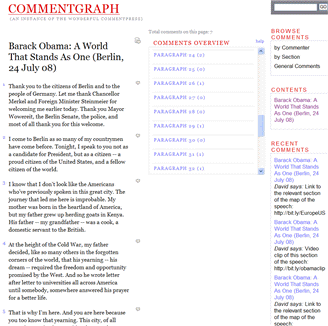Public Services 2.0
Thanks to David Osimo‘s pioneering energy and imagination (and the enabling support of FutureGov and Headshift), I was privileged to have the opportunity to outline some of the thinking behind Debategraph at the European Commission’s Public Services 2.0 workshop in Brussels last month.
As David described in the agenda for the workshop:
“Over the last 3 years, we have seen a dramatic rise in user driven, web 2.0 style initiatives in and around public sector service provision. Initiatives such as Patient Opinion, Farmsubsidy and Theyworkforyou all seek to challenge, disrupt and improve on traditional models of public service delivery from the outside, built on the web 2.0 principles of openness, transparency and sharing.
Against this background the workshop “aimed to bring together the best experiences from all over Europe” to: share experience and knowledge between the people running the web 2.0 initiatives; promote a surge of collaborative initiatives; and raise awareness and better understanding between government officials about why and how to promote web 2.0 in government.
The workshop was a great success across all these dimensions, and the slides and videos for all of the presentations are worth exploring in depth.
On a personal note, one of the joys of the event was the chance it afforded to meet people whose work I have long admired from a distance including James Munro, Lee Bryant, Anna Maybank, Dominic Campbell, Justin Kerr-Stevens, Emma Mulqueeny, Richard Stirling, Ivo Gormley – whose highly recommended film Us Now features Debategraph briefly and tantalisingly on screen at a key moment – and Søren Duus Østergaard.
In the aftermath of the workshop it has been delightful to see the same sense experimental adventure bubbling up elsewhere, and in the European context, the next collaborative step, emerging as spontaneous initiative from the workshop, is to imbue the European Commission’s imminent consultation on the i2020 strategy with more of the same spirit.
Of which more later.
Mapping Obama’s Speech in Berlin
As announced on the Global Sensemaking blog, and building on Tim Bonnemann’s excellent Wordle and Mark Szpakowski’s suggestion, I produced a draft map of Barack Obama’s speech in Berlin yesterday, which you can view and explore here.
The snapshot below displays the top layer of the map, and you are welcome to log-in and improve both the top layer and the underlying structure of the first draft.
As noted in the earlier post, the preparation of the first draft of the map emphasised the different senses, dimensions and saliencies of the speech that emerge via the different forms and interpretations: video, transcript, Wordle, and map. And, no doubt, others experiencing Obama’s speech first via TV news analysis, newspaper reports, David Frum, a photograph, or at the speech itself would take away different senses too.
To illustrate how it is possible to develop this kind of mapping analysis further live on the web already, I have started to weave together the map and the transcript of the speech using the Future of the Book’s marvellous CommentPress tool to enable directly addressable, granular access to the text of Barack Obama’s speech, linked to the relevant sections of the map (and vice versa)—with a video clip layered into the latter example for good measure as well.

The granular addressability is shown at the paragraph level in this example; however, CommentPress—which is being applied imaginatively to several public consultations in the UK—allows the user to define a deeper level of granularity, enabling a finer one-to-one correspondence between the source document and the map.
The hope embodied in this experiment is that in the build up to the Presidential election in November it might be possible exemplify the potential of the emerging web technologies to shift the modus of political debate (a degree or two) away from the calculated cacophony of ephemeral soundbites toward a more considered, constructive and cumulative conversation.
If you are willing to help in the pursuit of this goal—working on the transcripts, mapping and tying together the arguments, highlighting inconsistencies and areas of agreement, and holding the candidates transparently accountable to their words—please join us.

